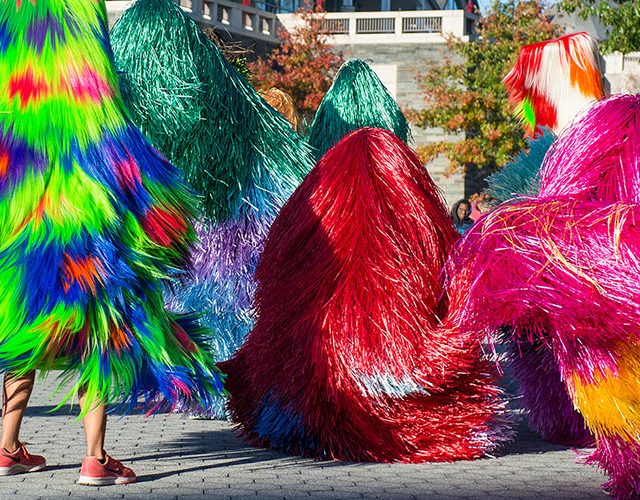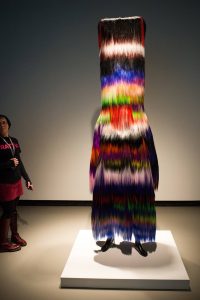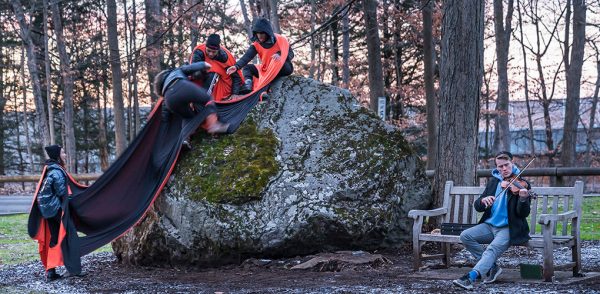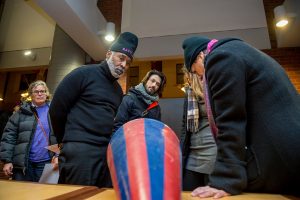
Shake, Rattle, and Roll
In an empty room, a mannequin and a vibrantly colored, synthetic fur garment lay on the floor.
This garment, called a “Soundsuit,” is a wearable sculpture created by Nick Cave, the Christian A. Johnson Visiting Artist in Residence last fall. It’s mid-October and Cave is working speedily with art and art history professor Lynn Schwarzer to set up his exhibition in Clifford Gallery. Soon, the Soundsuit adorns the mannequin. As the first thing gallery visitors see, the suit is striking.
Cave’s fall exhibition was called Rattle, and the art was as noisy as the name.
“[I’m] always looking for adjectives, words that speak about action and taking a position, such as ‘rattle.’ Rattle is about sound, making noise, generating attention, responding to something,” Cave said. “Right now we’re in such a critical time — there is an urgency in that word. The word comes off as fun and innocent, but it can really be proactive, direct.”
Cave is a multimedia artist whose work encompasses sculpture, performance, fashion, installation, and more. He’s also a professor in the fashion design department at the School of the Art Institute of Chicago.
His famed Soundsuits, arguably the pieces of art he’s best known for, adhere to his rattle philosophy — they’re meant to grab attention. The ones he brought to Colgate are colorful and extravagant, some with bright hues and pieces that sway with movement. The suits also serve another purpose: They “provide protection and anonymity in times when categorizing by race, gender, class is the first impulse,” Schwarzer said. “Wearing a Soundsuit, then, is both liberating and empowering.”
On the afternoon of Oct. 20, the community witnessed Cave’s work in motion as a procession flowed from the chapel to Little Hall, where the exhibition component of Rattle was displayed in the Clifford Gallery. The traveling performance started out with 12 people wearing Soundsuits, and once they started moving, onlookers joined in, dancing and following along. The procession didn’t stay outdoors — it entered the normally quiet space of Case-Geyer Library. “So as students were going to class, they ran into this sort of invasion,” Cave said. “It’s always interesting when something can alter your day.”
Outside of the chapel, students, faculty, and staff musicians provided the beats to start the performance with clanging percussion instruments. Students in street clothes kept it moving with funky tunes blasting from tiny radios.
Some of the suits made soft, swishing sounds, like a cheerleader’s pom-pom. They swayed easily as students marched forward and danced in circles. Other suits were 8- to 9-feet tall and had a stiffness supported by metal framework; they had the effect of long animal fur moving subtly. Depending on which Soundsuit students wore, they had varying experiences.
“Marching in the Soundsuit was fascinatingly disorienting,” said Christina Weiler ’21, who intends to major in environmental economics. “The sensations of wearing the suit were unfamiliar, such as carrying weight with my shoulders, legs, and arms all at once.”
In addition to the physicality of wearing the suit, Weiler commented on the communal feeling of the experience: “I walked the routes I usually take to get to class while having a completely different intention. In the suit, my job was to move for the sake of self-expression and being together, not just to get from point A to point B.”
Students get to work
One of the reasons Cave came to Colgate was because he wanted to help students express themselves.
“As an artist, an educator, I think it’s a responsibility,” he said. “Students need alternative ways of expression, building morale, and coming together collectively.”
So, in addition to the Rattle procession, students had another way to get involved during Cave’s time at Colgate: workshops.
“The workshops and residency are about bringing together a group of students who perhaps never even met each other and to think about a narrative or a point of view that they feel is necessary to express,” Cave said.
Tasked with creating a performance around an object provided by Cave, students spanning class years and majors banded together in the name of art. In each of the three workshops — with the titles Glitch, Hailer, and Lineage — the students had one prop to work with: alphabetical letters crafted by the students, old-fashioned cheerleader megaphones, and a stretchy article of clothing, respectively.
Cave checked in with students to give them advice, but armed with a prompt and their objects, they were largely on their own. “It’s all just about ideas,” Cave said.
Mykel Macedon ’19, a political science major, became interested in participating in Cave’s workshops when he saw Cave’s art for the first time. (The Soundsuits, in particular, piqued his curiosity.) Once Macedon learned more about the workshops, he decided to join Glitch — a word-association exercise — and Lineage, which was more of a physical performance. As an avid dancer, Macedon hoped to bring that form of art to Cave’s workshops.
“Dance is something I always do for fun,” he said. “It’s a stress reliever.”
In Lineage, students centered their performance around a swath of reversible black and orange cloth. The garment, complete with enough holes to fit the limbs of numerous people, required students to be in close proximity but it also stretched, allowing performers to enclose themselves as a group or open up to reveal individual movements.
To figure out how they wanted to perform, the group tried a series of exercises with the cloth. They thought about it symbolically and stretched it into different shapes. They unraveled it and raveled it again.
For their performance, the four Lineage group members weaved their limbs through the cloth and, as a student improvised violin music on a bench nearby, they ebbed and flowed. The stretch of the cloth allowed them to move separately, but it only extended a few yards, so they were still bound together — even when one student climbed upon a large rock, the others had to follow. Finally, they circled portions of the audience and moved them as a group. “So, by the end, all who came to watch became part of the performance themselves,” Schwarzer explained.
“We began to realize the freedom that we possessed while connected within the cloth, and temporarily forming a new being,” Macedon said. “In contrast to these possibilities and freedom, we incorporated the theme of prison, which was inspired by the orange color on one side of the cloth and the concept of being constrained and more specifically constrained to others. For Jabari [Ajao ’18] and myself, being black men in the United States, this theme was also inspired by a deep-rooted fear of the U.S. criminal justice system. Although the four of us became one, we each ultimately experienced Lineage differently.”
Cave is no longer on campus, but his work has left a lasting impression. “Since the performance, every time I reflect on it, I gain a knew depth to my understanding of Lineage.” Macedon said.
In addition, the athletics department will show video of Glitch at halftime at events, and students hope to continue working on the poetry-focused workshop Hailer.
— Rebecca Docter









